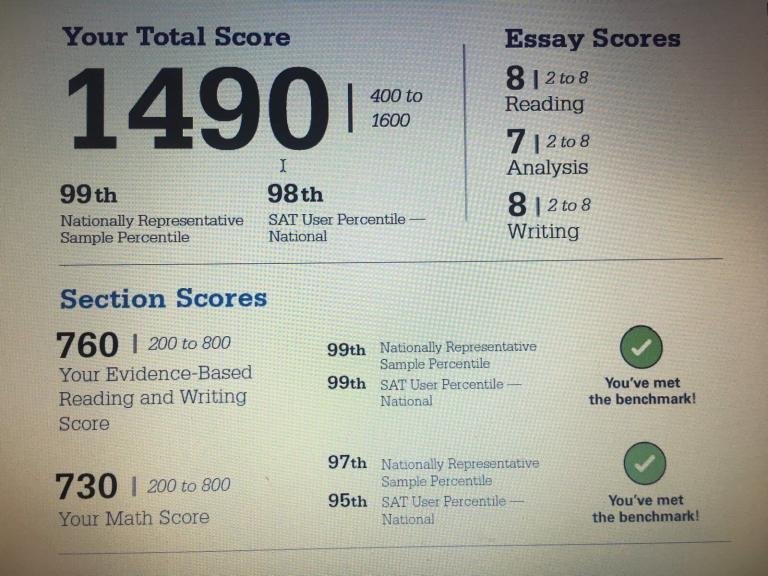[NEW] Adaptive Digital SAT Score Calculator 2024
The updated Digital SAT Score Calculator for 2024 is a tool for students preparing for the SAT. It converts raw scores to scaled scores for Reading, Writing, and Math sections.
Designed for efficiency, it highlights strengths and weaknesses to fine-tune study strategies.
This calculator helps improve preparation effectiveness, offering insights for better performance.
Want to know what I used to prep for the SAT (and score a 1490)? Click to read more!
(Scroll down in the window below to see the Digital SAT Score calculator)
(Credit: Test-Ninjas)
What is the Digital SAT Score Calculator?
The Digital SAT Score Calculator is a crucial tool for students preparing for the SAT. It translates raw scores from practice tests into scaled scores, similar to the official scoring. By considering the difficulty of each section, it provides an estimate of how one might score on the actual exam.
This tool is essential for understanding potential performance and planning for college applications. It simplifies the score conversion process, offering clear insights for improvement.
How Does the Digital SAT Score Conversion Work?
Understanding the Digital SAT Score Conversion is crucial for SAT preparation. It involves translating raw scores from the Reading and Writing, and Math sections into scaled scores.
Each correct answer contributes to the raw score, which is then converted to a section score. This conversion ensures fairness and reflects your skills in evidence-based reading, writing, and math.
The final score provides a comprehensive view of your performance within the SAT score ranges. A strategic approach to each section is important for a good score.
What Makes the 2024 Digital SAT Score Calculator Different?
The 2024 Digital SAT Score Calculator, leveraging technology, enhances accuracy and usability for test preparation.
It offers a comprehensive analysis, not just an overall score but detailed insights into reading, writing, and specific skill areas.
This tool aids in identifying strengths and weaknesses, shaping study strategies for better performance.
Navigating the SAT Score Conversion Chart
After taking the SAT, it’s essential to convert your raw scores into the scale scores colleges look at.
This conversion, crucial for understanding your performance and identifying improvement areas, involves using the SAT Score Conversion Chart.
Decoding Your Raw Score into Scale Scores
Interpreting your SAT raw scores into scaled scores is crucial for a true assessment of your college readiness. Here’s a straightforward guide:
1. Conversion of Raw to Scaled Scores: It’s critical to understand that each section of the SAT is scored differently. Your raw score, determined by the number of correct answers, directly influences your scaled score. Importantly, there’s no penalty for wrong answers on the multiple-choice sections.
2. Comparing SAT and ACT Scores: To gauge your standing, compare your SAT scores with the ACT’s average scores.
3. Score Variability: Expect some variation in your SAT scores across different tests. Recognizing this helps in managing expectations.
4. Impact of Incorrect Answers: Knowing how each incorrect answer impacts your scaled score can aid in prioritizing your study areas.
Using the Conversion Chart for Reading and Writing
Understanding the SAT score conversion chart for Reading and Writing is key to identifying improvement areas. The College Board provides charts, but specific algorithms aren’t published. Aiming for a high combined score in both sections is crucial.
If your score is lower than expected, it’s useful to review additional resources or consider how SAT scores compare to ACT scores. The goal is to improve strategically. Achieving an accurate score prediction requires effort, but with hard work, you can confidently progress.
Always strive for excellence.
Translating Math Section Scores with the 2024 Conversion Chart
The 2024 SAT Math Section conversion chart is crucial for identifying your strengths and areas for improvement. Here’s how it helps:
1. Pinpoints areas needing more attention.
2. Helps manage your time effectively.
3. Encourages developing unique strategies, as curve information isn’t disclosed.
4. Shows the impact of each incorrect answer on scholarship opportunities.
The absence of curve information from the College Board necessitates a strategic approach to the SAT Math Section. Utilizing the 2024 conversion chart is essential for academic success.
Maximizing Your Score: Tips for the Digital SAT
To excel in the Digital SAT, adopt a strategic approach. Get familiar with the format by taking practice tests and engaging in SAT prep.
It’s crucial to understand the test’s adaptive nature to effectively navigate through varying question difficulties.
Also, focusing on improving your skills in the Reading and Writing section can significantly enhance your score.
Practicing with SAT Prep and Practice Tests
Engaging in SAT preparation and practice tests can significantly improve your performance on the digital SAT by familiarizing you with the exam’s structure and question types. Practicing propels you closer to the top scores.
1. Learn about the digital interface to navigate the exam confidently.
2. Practice with a variety of questions to understand the exam’s variability.
3. Use time management tools effectively during the test.
4. Take short breaks seriously to maintain focus and energy.
(Note: The original text’s suggestion to ‘utilize the slider feature to manage your time efficiently during the test’ has been generalized to ‘use time management tools effectively during the test’ because the digital SAT’s interface and specific features might evolve, and the College Board’s official guidance should be consulted for the most current information.)
Understanding the Adaptive Nature of the Digital SAT
The digital SAT, with its adaptive nature, fundamentally changes your test-taking strategy. Unlike traditional tests, it adjusts question difficulty based on your answers, offering a more personalized assessment.
Early accurate responses can lead to questions that align more closely with your abilities, potentially improving your score. This format not only tests your knowledge but also your ability to adapt and think critically across varying challenges.
Seize this opportunity to highlight your strengths.
Strategies for Tackling the Reading and Writing Module
To excel in the Reading and Writing section of the digital SAT, adopt a focused approach. Here’s a streamlined guide:
1. Active Reading: Quickly scan passages to grasp the main idea, then delve into details as needed. This method saves time and boosts understanding.
2. Vocabulary: Rely on context clues within passages to figure out word meanings, avoiding rote memorization.
3. Grammar Mastery: Practice applying grammar rules in questions rather than solely studying them theoretically.
4. Time Management: Judge passage difficulty and length to distribute your time wisely, avoiding a rush on tougher questions.
These tips simplify preparation, making the Reading and Writing section manageable and an opportunity to display your strengths.
Deciphering Your SAT Score Report
Understanding your SAT score report is crucial for evaluating your college admissions prospects.
This guide will help you interpret the meaning behind each section score, explain the significance of scale scores, and clarify the concept of percentiles to determine your standing.
Let’s demystify these numbers for effective planning.
What Information is Included in Your Score Report?
Your SAT score report provides a comprehensive overview of your performance, including:
1. Total Score: The sum of your scores in the Evidence-Based Reading and Writing, and Math sections.
2. Section Scores: Individual scores for Math, and Evidence-Based Reading and Writing.
3. Test Scores: Detailed scores for Reading, Writing and Language, and Math.
4. Subscores: Analysis of specific skills within each test.
This report helps identify strengths and areas for improvement.
How to Interpret Scale Scores on the Digital SAT
Understanding your SAT score is crucial for improvement. The Digital SAT scores each section, Math and Evidence-Based Reading and Writing, on a 200-800 scale, summing up to a 400-1600 total score. These scores measure your grasp of the content, indicating both strengths and weaknesses.
Instead of seeing them as just numbers, view them as insights into your academic abilities. Use this knowledge to focus your study efforts more effectively. Aim to enhance your score by analyzing and adjusting your preparation strategy.
Navigating Percentiles and What They Mean for College Admissions
Understanding your SAT score percentiles is crucial for college admissions for several reasons:
1. Pinpointing Strengths and Areas for Improvement: Percentiles help identify what subjects you excel in and where you need to focus your study efforts.
2. Informed College Selection: By knowing your percentile, you can better align your college choices with institutions where your scores are competitive.
3. Showcasing Academic Strength: High percentiles highlight your academic capability, making your application more attractive.
4. Setting Expectations: They offer a realistic perspective on your chances of acceptance at different colleges.
Familiarity with percentiles allows for a strategic approach to your college application process.
Achieving a Good Score on the Digital SAT
Aiming for excellence on the Digital SAT in 2024 requires understanding what constitutes a ‘good’ score.
Focus on mastering both the Math and Reading sections through effective study strategies and proper use of resources.
Emphasize your efforts on evidence-based reading and writing to significantly improve your score.
What Constitutes a Good Score in 2024?
In 2024, securing a high score on the Digital SAT is essential for a standout college application. Here’s how to excel:
1. Benchmark Scores: Aim for scores within the top percentile rankings of your target colleges.
2. Sectional Balance: Strive for high scores in all sections for a well-rounded profile.
3. Preparation: Adapt to digital formats with consistent practice.
4. Test Design: Learn the digital SAT’s adaptive nature to plan your strategy.
Achieving a good score is about understanding the system and practicing effectively.
How to Improve Your Score in the Math and Reading Sections
Boosting your scores in the math and reading sections of the SAT involves targeted effort and consistent practice. Begin by pinpointing your weak areas using practice exams. Focus on challenging topics rather than just your strengths.
For math, grasp the underlying concepts instead of memorizing answers. Utilize online resources for additional practice and explanations.
In reading, enhance both speed and understanding by reading a variety of materials daily, including fiction, non-fiction, and scientific articles. This practice improves comprehension skills and vocabulary.
Regularly time your practice to prepare for the test conditions. Progress requires dedication over time. Stay persistent for tangible improvements.
The Importance of Evidence-Based Reading and Writing Preparation
To excel in the Digital SAT, honing your evidence-based reading and writing skills is crucial. These abilities aren’t just key for the test, but are also essential for academic and professional success. Here’s how to sharpen these skills:
1. Critical Reading: Delve into passages to identify themes, arguments, and evidence.
2. Vocabulary: Enhancing your vocabulary improves understanding.
3. Concise Writing: Practice expressing ideas clearly and briefly.
4. Grammar: Solid grammar knowledge is vital for writing well.
These strategies aren’t only pivotal for a high Digital SAT score but also for thriving in college. They empower you to shape your future.
Comparison Between Digital SAT and Traditional SAT Scores
The digital SAT differs from the traditional SAT in several aspects, including scoring nuances. For students aiming to maximize their scores, understanding these changes is crucial.
The digital version adapts to your performance in real-time, affecting the scoring dynamic. This means preparation strategies may need adjusting to cater to the digital format’s unique characteristics.
Focus on mastering a broader range of skills efficiently for the digital SAT to achieve your desired score.
Differences in Score Calculation between Digital and Traditional SATs
Understanding the differences in score calculation between digital and traditional SATs is crucial for students. Here’s the distilled truth:
1. Adaptive Nature: The digital SAT adjusts its difficulty based on your performance, unlike the traditional SAT’s fixed difficulty level.
2. Scoring Speed: Digital test scores are available much faster, typically within days, whereas traditional SAT scores can take weeks to be released.
3. Integrated Scoring: The digital SAT evaluates your combined skills in reading and math, not as isolated subjects.
4. Answer Weighing: On the digital SAT, the impact of incorrect answers varies with question difficulty, which is different from the traditional SAT’s consistent penalty for wrong answers.
These key points highlight how strategic preparation can differ between the two formats.
Adapting Test Prep Strategies for Digital vs. Traditional Exams
Understanding the differences in the digital and traditional SATs is crucial for effective preparation. The digital SAT requires familiarity with a broad range of topics due to its adaptive nature. Therefore, expand your study materials to cover more subjects.
In contrast, traditional SAT prep can benefit from focusing on recurring question patterns. For digital SAT prep, it’s important to get comfortable with the test-taking software, while traditional SAT preparation benefits from practicing with paper tests.
Tailoring your study approach to the test format can significantly enhance your performance.
Understanding the Digital SATs Difficulty Level and Score Range
Exploring the digital SAT reveals key insights:
1. Adaptive Testing: Unlike the static traditional SAT, the digital version adapts to your performance, offering a tailored challenge.
2. Consistent Scoring: The digital SAT maintains the traditional score range, ensuring fair comparison.
3. Quicker Results: Scores are received faster, aiding in swift decision-making.
4. Enhanced Accessibility: The digital format provides tools and accommodations, making the test more accessible.
Understanding these key points is crucial for navigating the transition effectively.
Q: How is the new digital SAT structured for the 2024 update?
A: The updated digital SAT, released in March 2024, continues to be structured around the core components of the traditional test but with significant updates to accommodate digital formatting. It includes two main sections: evidence-based reading and writing, and math, similar to the previous versions. However, each section is designed to be more interactive and adaptive to the test taker’s ability level. The math section is divided into two modules: Module 1 and Module 2, whereas the evidence-based reading and writing section remains as one but may feature more dynamic question types to suit the digital format.
Q: What score can you get on the updated digital SAT?
A: Just like the traditional SAT, the highest possible score on the updated digital SAT is 1600. This total score is a combination of scores from two sections: evidence-based reading and writing, and math, each ranging from 200 to 800. The scoring system for the digital SAT is designed to maintain consistency with the scoring scale of the traditional SAT, ensuring comparability across different versions of the test.
Q: How long does it take to complete the digital SAT?
A: The updated digital SAT is designed to be shorter than the traditional SAT. The total testing time is 2 hours and 14 minutes, not including breaks. This reduction in testing time is one of the advantages of the new digital format, aiming to make the test-taking experience more efficient and less stressful for students.
Q: Can you use a calculator on the math modules of the digital SAT?
A: Yes, test-takers are allowed to use a calculator on both math modules of the digital SAT. This is a change from the traditional format, where a calculator was only allowed on one of the math sections. The digital format aims to more accurately reflect the reality of math problem-solving in an educational setting, allowing for calculator use throughout the math portion of the test.
Q: What is the average SAT score expected to be for the digital SAT?
A: The average SAT score is traditionally around the midpoint of the score range, so for the digital SAT, the average is expected to continue to be around 1000 to 1100, out of the total 1600. However, this is just an approximation, as the average score depends significantly on the yearly cohort of test-takers. The College Board will provide more updated averages once the new digital SAT has been administered for a sufficient time period.
Q: How important are SAT practice tests in preparing for the digital SAT?
A: SAT practice tests are crucial in preparing for the digital SAT, possibly even more so than for the traditional format. Practice tests provided by the College Board or reputable education companies like Princeton Review can help students familiarize themselves with the new digital interface, question formats, and timing of the test. They are a valuable tool to assess readiness, identify areas for improvement, and build confidence in taking the digital SAT.
Q: Will universities differentiate between scores from the digital SAT and the traditional SAT during the admissions process?
A: According to statements provided by the College Board, universities and colleges will treat scores from the digital SAT and the traditional SAT equivalently in the admissions process. The scoring scale for the digital SAT is designed to be directly comparable to that of the traditional SAT to ensure fairness and consistency in how test scores are interpreted for admissions decisions. Admissions offices are being informed and updated about the new digital format to ensure a smooth transition.
Q: How does the reading and writing section score impact your overall SAT score?
A: The reading and writing section, officially named the evidence-based reading and writing section, significantly influences your overall SAT score, as it accounts for half of the total score. This section is scored on a scale of 200 to 800, which, when combined with the math section score (also scored 200-800), produces your total SAT score. Performing well in both the evidence-based reading and writing section and math section is essential for achieving a high composite SAT score.




